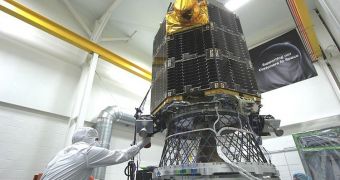Officials with the American space agency say that their new orbiter around the Moon, called the Lunar Atmosphere and Dust environment Explorer (LADEE), has successfully finished its commissioning and testing phases, and is now ready to begin conducting scientific investigations.
The primary science phase of the mission is scheduled to last around 100 days, though it may be extended if the spacecraft remains in good shape. The vehicle has already suffered a glitch on November 19, when one of its processors experienced a sudden reboot.
This led to the processor restarting in safe mode, a protective mode that prevented any damage from coming to the electronics. The error occurred right after LADEE had finished sending all data in its main memory to Earth. The glitch was fixed right away, and the mission resumed without incident.
The orbiter has already been conducting opportunistic science measurements for a few days, in coordination with the other NASA spacecraft at the Moon, Lunar Reconnaissance Orbiter (LRO). This collaboration began on November 10, when LADEE entered its elliptic, pre-science orbit.
The mission launched aboard a Minotaur V rocket from the Mid-Atlantic Regional Spaceport's Launch Pad 0, at the NASA Wallops Flight Facility, in Virginia. Takeoff occurred on September 7, at 03:27 UTC. The 383-kilogram (844-pound) vehicle achieved orbital insertion around the Moon on October 6.
“The team was able to conduct preliminary science activities when LADEE’s orbit brought it closest to the surface of the moon and across the sunrise terminator – the transition from night to day,” NASA LADEE mission controllers say in a statement.
“After those science activities LADEE completed the fourth and final block of Lunar Laser Communication Demonstration (LLCD) operations in the commissioning phase,” the team adds. The mission is managed by the NASA Ames Research Center (ARC), in Moffett Field, California.
LADEE was launched to analyze the lunar atmosphere and exosphere, and to gain additional insight into radiations reported to occur high above the surface of the Moon. Additionally, it will be conducting measurements on the properties of lunar dust.

 14 DAY TRIAL //
14 DAY TRIAL //